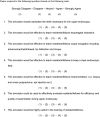Fabrication and Validation of a Cost-Effective Upper Endoscopy Simulator
- PMID: 33100816
- PMCID: PMC7546778
- DOI: 10.4293/JSLS.2020.00034
Fabrication and Validation of a Cost-Effective Upper Endoscopy Simulator
Abstract
Purpose: Beginning with the graduating class of 2018, the American Board of Surgery (ABS) requires that residents complete the ABS Flexible Endoscopy Curriculum, Fundamentals of Endoscopic Surgery (FES). This curriculum includes both didactic and simulator training. In the ideal setting residents gain proficiency using simulation prior to performing endoscopies in the clinical setting. This new requirement creates an increased demand for endoscopic simulators in all General Surgery residency programs. Due to the cost prohibitive nature of virtual reality simulators an economic alternative is needed.
Methods: A mechanical simulator was created from inexpensive items easily acquired at a hardware store and in the hospital. Total cost of the simulator was approximately $120 USD. To validate the simulator, experienced endoscopists completed a training session with the device. A seven-question Likert scale survey (1 - strongly disagree to 5 - strongly agree) was completed after the session evaluated the simulated experience versus live upper endoscopies and the device's ability to meet the goals of the FES curriculum.
Results: Eight proficient endoscopists completed the training session and survey and agreed that the device closely replicated live colonoscopies and would meet all training requirements in the FES curriculum. Mean responses to all seven survey questions ranged from 3.8-4.4.
Conclusion: This device is a cost-effective method for simulating live upper endoscopies and is appropriate for use in FES training.
Keywords: EGD simulator; Endoscopy; General surgery residency; Residency; Simulation.
© 2020 by JSLS, Journal of the Society of Laparoscopic & Robotic Surgeons.
Conflict of interest statement
Conflicts of Interest: The authors declare no conflicts of interest.
Figures
References
-
- American Board of Surgery. The American Board of Surgery Booklet of Information. 2018. http://absurgery.org/xfer/BookletofInfo-Surgery.pdf. Accessed June 28, 2018.
-
- Anatomy Warehouse. Koken EGD simulator. https://www.anatomywarehouse.com/koken-egd-simulator-a-105294. Accessed November 4, 2019.
-
- Bittner JG, Marks JM, Dunkin BJ, Richards WO, Onders RP, Mellinger JD. Resident training in flexible gastrointestinal endoscopy: a review of current issues and options. J Surg Educ. 2007;64(6):399–409. - PubMed
-
- National Cancer Institute. Anatomy of the Esophagus. https://training.seer.cancer.gov/ugi/anatomy/esophagus.html. Accessed November 4, 2019.
Publication types
MeSH terms
LinkOut - more resources
Full Text Sources
Miscellaneous






